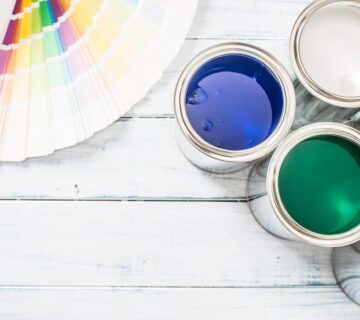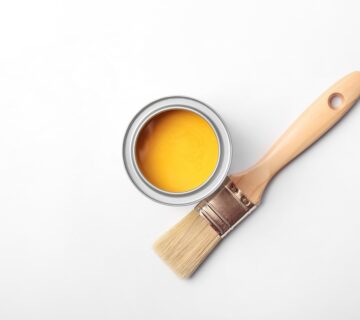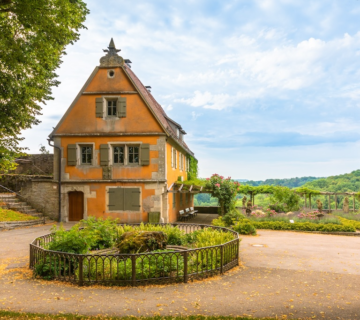The colors and textures we choose to adorn our homes narrate history, express creativity, and showcase identity. They play a key role in how we perceive our space and set the atmosphere for daily living. Additionally, colors can evoke emotions and memories, connecting us to our past while reflecting our current tastes. Each choice in hue and texture is a personal touch, adding to the story of our homes.
Ancient Vibrancy: Mediterranean Origins
Mediterranean colors, reflecting the sun and cooling homes, have become a cherished regional signature. The warm palette not only serves a functional purpose but also contributes to the distinctive character of Mediterranean architecture. These hues are a celebration of culture, evoking the spirit of the region’s rich history and lifestyle. The interplay of light and color on these walls offers an endless dance between architecture and the environment.
Renaissance Splendor: The Italian Influence
Moving into the Renaissance, Italian villas displayed frescoed walls, often mimicking the opulent materials of marble and gold. This elaborate style spoke of wealth and status, influencing noble houses far beyond Italy’s borders. The legacy of these painting techniques is still evident in the grandeur of European architecture. Such frescoes were not mere decorations; they were also statements of power and cultural sophistication that continue to inspire awe and emulation.
Colonial Shades: A New World Palette
In North America, the soft sage greens, rich blues, and deep reds of colonial homes echo the settlers’ longing for the Old World and their adjustment to the New. Remaining popular in historic districts, these hues offer continuity amidst change, bridging the past to the present. They also represent a narrative of adaptation, as settlers infused their new environments with the comforts of their distant homelands.
Victorian Ornamentation: A Play of Patterns and Hue
The Victorian era brought a love for intricacy and detail to architectural painting. With the industrial revolution’s new pigments and wallpapers, homes were treated to a tapestry of color and pattern. From the intricate “gingerbread” trims to the bold color contrasts, Victorian styling continues to be a touchstone for ornate design in modern painting trends. The exuberance of Victorian design reflects the optimism of an age that reveled in progress and prosperity.
Bauhaus and Beyond: The Impact of Modernism
The advent of the Bauhaus movement stripped back the excesses of previous styles and introduced the sleek lines and block colors that would become the blueprint for modernist and contemporary homes. This minimalist approach, with its stark whites, grays, and bold color accents, reshaped our concept of home aesthetics and inspired the minimalist and Scandinavian styles that are en vogue today. Bauhaus’s legacy endures, championing functionality alongside form. Its influence can be seen in the clean and functional design language that dominates much of modern architecture.
Art Deco and Miami Pastels: A Tropical Palette
Art Deco’s pastel hues and geometric designs celebrate human creativity and resilience. The pastel hues and geometric designs of Art Deco architecture stand as a celebration of human creativity and resilience through design. They serve as a vibrant reminder of the roaring twenties, a decade marked by both hedonism and innovation. This movement’s influence persists in the colorful skylines and decorative details that define the era’s enduring charm.
Expression and Community: Murals and Street Art
Murals transform walls into forums for social dialogue and cultural storytelling. In the latter half of the 20th century and into the 21st, murals and street art brought bold expressions of community identity and political statement to the exteriors of buildings. This art form has become an important facet of urban culture, with cities across the globe boasting iconic murals that attract tourism and foster community pride. Street art has shifted from being a fringe activity to a celebrated medium of public expression and engagement.
Sustainable and Smart: The Future of House Painting
Eco-friendly paints and smart coatings are emerging, transforming house painting’s function and aesthetic. These innovations are redefining the role of paint in our lives, not only as an aspect of decor but as an active player in home sustainability. The future of house painting may actively contribute to our well-being and planetary health. As we move towards a more sustainable future, these advancements promise to integrate environmental stewardship into the very walls of our homes.
Final Thoughts
The paint on our walls does more than weatherproof; it tells stories, influences moods, and reflects the zeitgeist of an era. As we continue to paint our homes, we contribute to a living history—a canvas that shows who we are and where we have been. House painting, in all its forms, is not just about the colors we choose but the mark we leave on the fabric of our habitats. Moreover, it is a reflection of our journey through time, documenting our collective aspirations, challenges, and achievements in the strokes and palettes we leave behind. For more insights into historical architectural and painting styles, visit our website at sisupainting.com and explore our blog at sisupainting.com/blog.




No comment